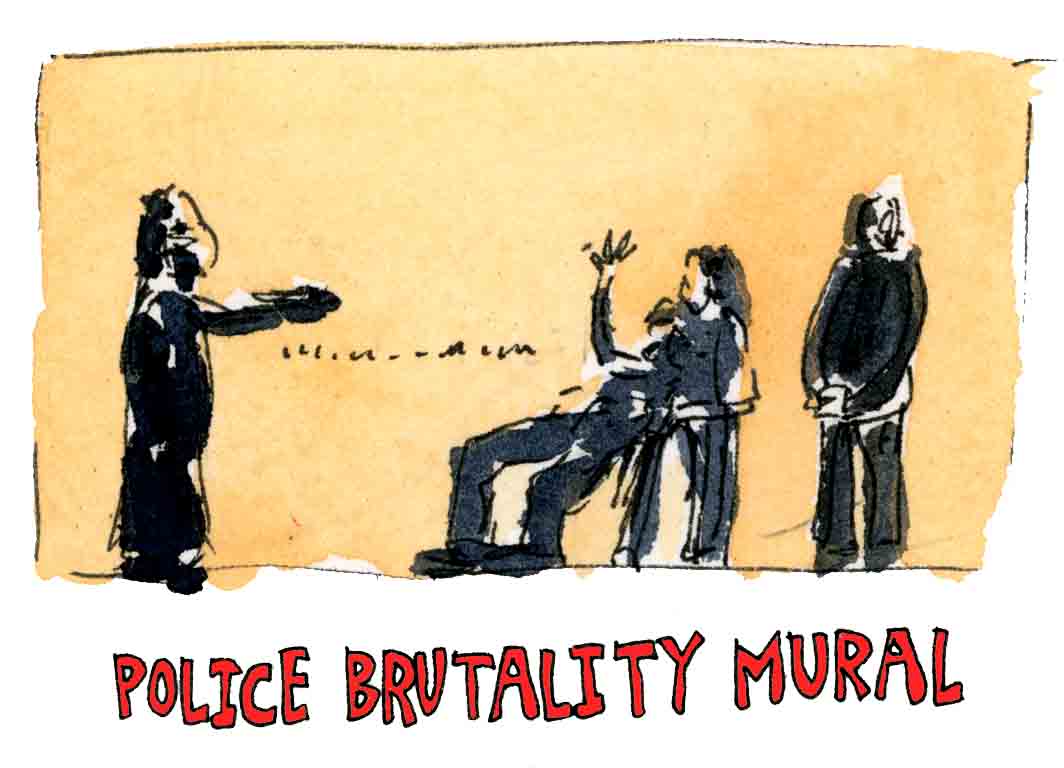
Police Brutality Mural (Illustration by: Emma Fick)
Around March of 2018 I had a presentation due about a piece of graffiti, and in that class we had just finished talking about an anonymous artist who is known as Banksy. Seeing a piece by this believed Banksy artist I was really intrigued, so I decided to write about it. As I did more research and learned more about the public art, I uncovered that this Banksy piece wasn’t a Banksy piece at all. It was the work of New Orleans graffiti artist Az.
“Why graffiti?” AZ asks before answering, “I don’t like being told what to do. I think displaying in public places makes people value and respect art differently. They don’t treat it like they do when it’s in a gallery or museum, or in someone’s house. They almost treat it like it’s theirs.” This concept of ownership and art is present in AZ’s life.
Although Az has many fans in New Orleans, he has no problem with people other than New Orleanians using the “New Orleans Style.” Az feels that, “…people should use what inspires them to enhance and deepen their own style. Copy, no, of course not. Not publicly, at least. Copying is what you do to learn. When you’re ready to display it, [it] means you’ve developed your own methods and drives and techniques. Being inspired by others’ work at that point is what every artist has done to develop themselves and their styles since painting first started.”
In a city that prides itself on being one-of-a-kind, this issue of “authenticity” is always a talking point with artists, New Orleanians, and even tourists. AZ finds ways to play around with these rather tense issues.
In fact, one of his panhandling events involved a robot holding a sign that said: “WILL WORK 4 FRIENDS.” At first glance onlookers may smile at this robotic panhandling, but AZ has a deeper message with this. “Now, it’s silly for a robot to beg, right?” he asks. “They don’t need anything REALLY… right? But the real question is: how often do we say similar things when that’s a person out there, begging? So we create an idyllic world, compare it to ours, and the art should have the effect that comparison has.”
Az is a sensational artist who has an impressive way to turn society’s issues into art, and one of Az’s pieces stood out to me above all. This spectacular piece, located on the former camps of Carrollton area Alfred E. Priestley Junior High in uptown New Orleans, illustrates the moment when police officer Daniel Pantaleo of the NYPD put Eric Garner in a choke hold. Garner repeatedly yells, “I can’t breathe” until the police officer finally kills him.
Police Brutality has been an enormous issue in America, especially in the past century. There are some people who talk and bring attention to this defect in America, and then there are other people who are uneducated or don’t care about it.
In New Orleans, police brutality is a prominent issue, seeing as there are many complaints against the New Orleans Police Department. On December 19, 2016 former Mayor Mitch Landrieu announced that New Orleans was settling a three police brutality cases and giving 13.3 million dollars to victims of police brutality during hurricane Katrina in 2009. Az brings these issues to the forefront with his public art. In his piece, “May the force be with you” he represents the feeling of being approached by a police officer seeing as 857 people have been shot and killed by police officers since 2018 has begun. While highlighting the misuse of power by the police department, Az brings to light racial injustices.
Changing the justice system isn’t a one-person job, and it definitely won’t happen overnight, but if more and more people bring notice to these types of situations and statistics, then more people will be able to prevent these social justice issues. That is exactly what Az is doing.
Sources:
https://mappingpoliceviolence.org/
https://www.instagram.com/azwashere/
 NOLAbeings Multimedia artist Claire Bangser created NOLAbeings as a portrait-based story project that marries...
NOLAbeings Multimedia artist Claire Bangser created NOLAbeings as a portrait-based story project that marries...  Voodoo in New Orleans: Reviving history: New Orleans fortune telling This article takes a deep dive into the history of Voodoo in New Orleans, its hybridization with Catholicism, and its present-day place in the city's culture. The author visits fortune-tellers in the French Quarter, using their guidance as a tool for introspection rather than a deterministic predictor of the future. Through her experiences in New Orleans, the author feels a mystical connection to both the past and the future.
Voodoo in New Orleans: Reviving history: New Orleans fortune telling This article takes a deep dive into the history of Voodoo in New Orleans, its hybridization with Catholicism, and its present-day place in the city's culture. The author visits fortune-tellers in the French Quarter, using their guidance as a tool for introspection rather than a deterministic predictor of the future. Through her experiences in New Orleans, the author feels a mystical connection to both the past and the future. 